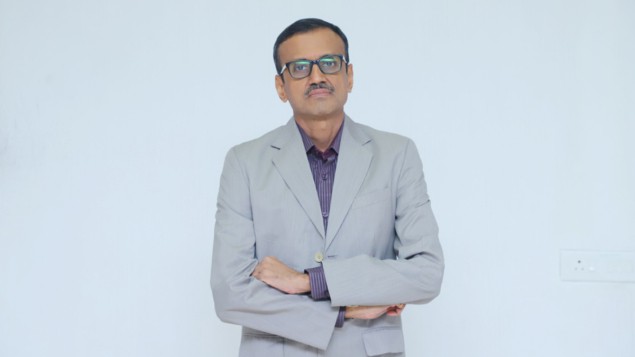Shri Rajesh Veeraraghavan, a director at the Nuclear Power Corporation of India, tells Chris North why he thinks nuclear power can help low-income nations transition to a carbon-neutral future

Shri Rajesh Veeraraghavan is a mechanical engineer who was appointed as technical director of the Nuclear Power Corporation of India Limited in July 2023. In December 2023 he presented the Homi Bhabha and Cockroft Walton lecture series – a bilateral exchange of lecturers between the Institute of Physics and Indian Physics Association, which have been running since 1998.
How do people in India view the subject of climate change?
I have seen the impact of climate change in my own home state of Kerala in southern India. In 2018 the region was hit by an unprecedented flood that remained for about a week or so. That is when many people realized that the impact of climate change is happening not just in other countries, but in India too.
What about the Indian government?
The government is trying to drive down the consumption of fossil fuels while at the same time making a push for renewables, especially solar, which is increasing hugely through rooftop arrays that are able to deliver energy to homes and businesses. For any change to happen, the population needs to be onboard and to help deliver renewable targets.
India is a low-income country and to become developed requires a lot of energy consumption
What are those targets?
India is committed that by 2070 we will be a net-zero emissions country. Yet at the same time we are a low-income country and to become developed requires a lot of energy consumption, which is why we still have a large dependence on coal. Global warming has already reached 1 °C above pre-industrial levels and keeping it within 1.5 °C is the target. Yet it is the high-income nations that have contributed the majority of carbon emissions that have been released in the last two centuries, so developing nations are not the main creator of the problem. So, while we have to develop as a nation, we are also at the same time working towards solving the problem of climate change.
How can India achieve this?
We have committed that by 2030 renewables will meet about 50% of electricity demand, up from 40% today. But we will also need nuclear. Today, the installed capacity of nuclear in India is around 7.3 GW – or about 3% of electricity generation – and that will double by 2030 to about 15 GW while still remaining at 3% of total energy produced. It is expected that India will require about 770 GW of total installed energy-generation capacity in 2030 compared with 415 GW today.
With the focus on renewables, does nuclear power have a future?
Yes, nuclear power has many advantages. A 1 GW nuclear plant will continuously provide 1 GW to the grid, operating 90% of the time. Wind or solar require sunlight or the wind to blow, which gives an operating capacity of about 30%. This requires ways to store that energy. As renewables alone cannot provide a continuous power supply, there has to be a mix of nuclear and fossil fuels with renewables.
How does the public in India view nuclear power?
The public in general accepts nuclear, but as in other countries, there is opposition. Some people say nuclear is unsafe, but we have operated some of our reactors continuously for years and of the 24 reactors currently in operation, we have not had one nuclear safety incident.
Are people concerned about issues around radiation safety?
The radiation you are exposed to from natural sources is of the order of 2400 microsievert (µSv) per year. The radiation that can be released into the atmosphere from a nuclear plant is heavily regulated. In India this is carried out by the Atomic Energy Regulatory Board and that number is required to be less than 1000 µSv per year. However, emissions at our nuclear plants are much less, ranging from 0.002 to 24 µSv per year.
What is the future of nuclear power in India?
The Indian nuclear physicist Homi Bhabha – credited as the father of India’s nuclear programme – envisaged a three-stage nuclear power programme for the country. The first stage is pressurized water reactors and currently India has a mix of pressurized heavy-water reactors and light-water reactors. The second stage is the development of fast breeder reactors, a prototype of which is being built in India. The third stage is thorium-based reactors, which India is ideally placed to lead given we have large thorium deposits.
Do small modular reactors have a future in India?
Such reactors, which generally produce less than 300 MW, are a beautiful technology and one that may revolutionize nuclear power. They can be assembled in a factory with minimum construction at the intended site. As of now, small modular reactors are mostly in the conceptual or design phase. But if implemented, it would be possible to power a small city by putting a single reactor on the outskirts, for example.
What benefits does the nuclear industry bring?
Establishing a nuclear plant gives many benefits. The local surroundings are developed, it provides jobs and companies also undertake social responsibility projects. We need nuclear power.
- SEO Powered Content & PR Distribution. Get Amplified Today.
- PlatoData.Network Vertical Generative Ai. Empower Yourself. Access Here.
- PlatoAiStream. Web3 Intelligence. Knowledge Amplified. Access Here.
- PlatoESG. Carbon, CleanTech, Energy, Environment, Solar, Waste Management. Access Here.
- PlatoHealth. Biotech and Clinical Trials Intelligence. Access Here.
- Source: https://physicsworld.com/a/how-india-is-transitioning-its-energy-production-in-a-carbon-constrained-world/



